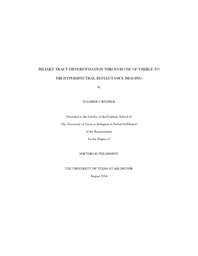| dc.description.abstract | Cholecystectomies are one of the most common surgeries performed in the United States, and most of the complications which arise from these are injuries to the common bile duct (CBD) resulting from a misidentification of anatomy. Reflectance hyperspectral imaging (HSI) offers a low-cost, non-invasive tool to record superficial chemical spectra of a field of view in many surgical applications. A NIR DLP HSI system is assembled and characterized, and used to gather preliminary CBD reflectance HSI data cubes. NIR hyperspectral imaging (760 nm to 1600 nm) with the DLP HSI system proves ineffectual, so CBD reflectance hyperspectral data collection progresses with the previously characterized visible DLP HSI system (380 nm to 780 nm). 13 human subjects are imaged with the visible DLP HSI system in open surgery. An average spectrum for the CBD is calculated and examined for its usefulness as a spectrum to detect the human CBD in the 13 image scenes.In order to select hyperspectral analysis techniques to assist in the location of the in vivo human CBD, an extensive review of existing hyperspectral analysis literature is performed. 18 out of 51 researched methods are selected for evaluation, and 4 detect the CBD successfully. The calculation of average tissue spectra is extended beyond the CBD to other tissues previously imaged with the visible DLP HSI system, in order to create a tissue spectral database. Tissues additionally characterized in this manner include human fat, kidney, gallbladder, liver, renal cyst, and pig kidney. These 5 tissue types, in addition to human CBD are compared statistically to each other with two different metrics: spectral angle distance, which compares two entire spectra at once, and t-tests performed in a wavelength-by-wavelength grouping. These two techniques both agree that the most similar tissue spectra to each other include oxygenated kidney and renal cyst tissue, and human and pig kidney.The results support the feasibility of using reflectance HSI to differentiate tissues found within a surgical scene and further support the use of pig renal tissue as animal test analogs to human renal tissue. Wavelength-by-wavelength statistical testing for each tissue comparison provides further information on the best spectral windows in which to detect spectral similarity and dissimilarity in biological tissue spectra. This preliminary database should prove easily expandable for future studies and reduce injury risk caused by misidentification of anatomy during surgery. | en_US |

